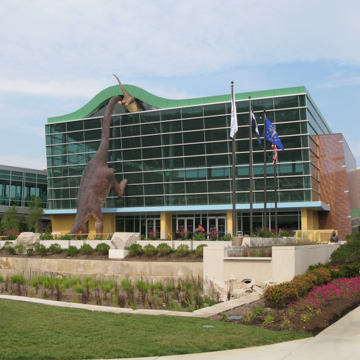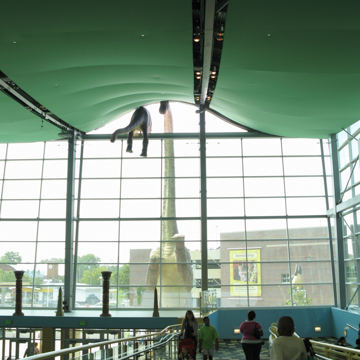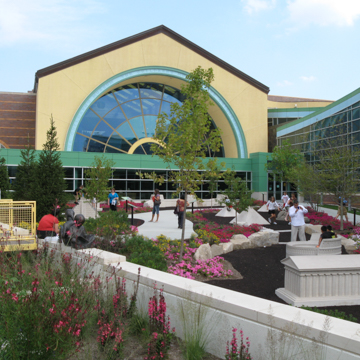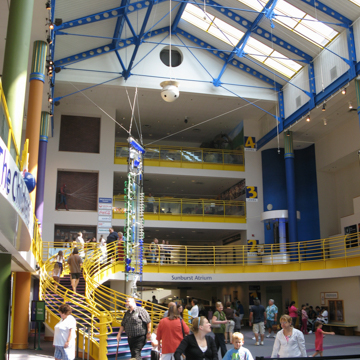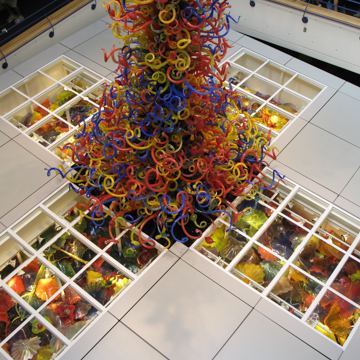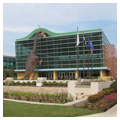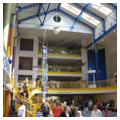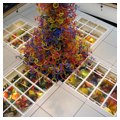The Indianapolis Children’s Museum, widely recognized for its excellence and innovation, is the fourth oldest and largest such institution in the world. The museum building is an exciting complex that incorporates bright colors, dramatic lighting, and life-size replicas of dinosaurs to inspire and engage children of all ages.
The concept of a children’s museum for Indianapolis was first explored by Mary Stewart Carey, a local socialite and advocate for childhood education. After a 1925 trip to the Brooklyn Children’s Museum, she gathered a group of like-minded civic leaders and started a small museum in a carriage house near downtown Indianapolis. The institution moved several times and finally purchased the historic Parry Mansion in 1946 at 3000 North Meridian Street in the Mid-North neighborhood. By the 1970s, the museum needed more space and demolished the Parry Mansion to make way for a new, modern structure to better meet their needs.
Indianapolis architects Wright, Porteous and Lowe designed the new museum building in 1976. The brick, five-story building included eight galleries, a theater, classrooms, offices, and space for exhibit design and construction. The design was almost Brutalist with heavy massing, a lack of ornament, flat brick planes, and inset corners. Interior ramps connected each story, wrapping around a central light well. “Rex”—a 20-foot-tall Tyrannosaurus Rex figure—guarded the entrance until 2005. The building was constructed around the “Reuben Wells,” a nineteenth-century railroad locomotive famous for scaling a steep incline near Madison, Indiana. One of the most popular exhibits was the historic 1917 Broad Ripple Park Carousel, which had been moved, restored, and installed on the fourth floor.
The Children’s Museum continued to expand over the years. The first addition was the Entrance Hall, an arched glass entry designed by local architect Evans Woollen in 1998. Also added that year was the Water Clock, a permanent fixture created by French physicist and artist Bernard Gitton; it is the largest clock of its kind in North America. Other additions included the 1989 SpaceQuest Planetarium, the 1990 Eli Lilly Center for Exploration, and the 1996 Dow Science Center. All of these additions were designed for children’s hands-on learning experiences.
To better incorporate the additions, in 1997 the main brick museum building was clad with an exterior insulation and finishing system. That same year, the addition of the CineDome Theatre also dramatically changed the appearance of the museum. The brick and pre-cast concrete structure resembles a stepped cone with the top sliced off. Colored diamond-patterned brickwork creates movement and whimsy. A life-size dinosaur appears to be escaping the theater, having just broken through the bricks. The structure was designed by local architects Browning Day Mullins Dierdorf, also known for Indianapolis’s Eiteljorg Museum of American Indian and Western Art.
Needing even more space, the Children’s Museum hired RATIO Architects to embark on a new master campus plan in the early 2000s. The CineDome was converted to Dinosphere in 2004, with several dinosaur figures added to the gathering spaces, and an elevated walkway connecting the museum to a new parking garage. An all-glass Welcome Center was completed in 2009. Two life-sized Brachiosaurs—named Seymour and Riad—seem to be pushing up the roof of the Welcome Center to gain a peek inside. The expansion also included the infoZone, the nation’s only full-service public library located within a museum.
In recent years, the Children’s Museum has made great efforts to revitalize the surrounding Mid-North neighborhood, which has experienced disinvestment since the mid-twentieth century. Working with the Local Initiative Support Corporation, the museum has implemented the Mid-North Quality of Life Plan, which includes the installation of public art, connecting the neighborhood to existing bike trails, and educating youth through project-based learning.
References
“The History.” Children’s Museum of Indianapolis. Accessed 22 June 2016. http://thehistory.childrensmuseum.org/.
Pearson, Clifford. “CineDome Indianapolis, Indiana.” Architectural Record(December 1997): 72-75.
“Putting on a Happy Face: the Children’s Museum, Indianapolis, Indiana, Woollen, Molzan and Partners.” Architectural Record177, no. 9 (August 1989): 78-81.














